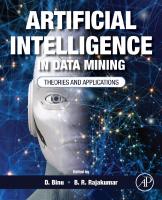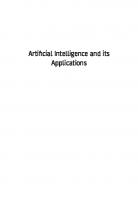Artificial Intelligence and Data Science in Recommendation System: Current Trends, Technologies and Applications 9815136763, 9789815136760
Artificial Intelligence and Data Science in Recommendation System: Current Trends, Technologies and Applications capture
138 47 27MB
English Pages [319]
Table of contents :
Cover
Title
Copyright
End User License Agreement
Contents
Foreword
Preface
List of Contributors
Study of Machine Learning for Recommendation Systems
Tushar Deshpande1,*, Khushi Chavan1 and Ramchandra Mangrulkar1
INTRODUCTION
Recommendation System
Machine Learning
Supervised learning
Semi-supervised learning
Unsupervised learning
Reinforcement learning
METHODS
Collaborative Filtering
Model-Based
Memory-Based
Content-based Filtering
Hybrid Filtering
Algorithms
Co-clustering
Matrix Factorization
K-Nearest Neighbors
K-means Clustering
Naive Bayes
Random Forest
Evaluation Methods
F1. Measure
RMSE (Root Mean Squared Error)
MAE (Mean Absolute Error)
EXPERIMENTATION
Dataset
Implementation
Result
DISCUSSION
CONCLUSION
ACKNOWLEDGEMENT
REFERENCES
Machine Learning Approaches for Text Mining
and Spam E-mail Filtering: Industry 4.0
Perspective
An Overview of Deep Learning-Based
Recommendation Systems and Evaluation Metrics
Towards Recommender Systems Integrating Contextual Information from Multiple Domains through Tensor Factorization
Douglas Véras1,*, André Nascimento1 and Gustavo Callou1
INTRODUCTION
Problem Statement
CD-CARS Overview
LITERATURE REVIEW
Cross-Domain RS
Definition of Domain
Cross-Domain Recommendation Tasks
Cross-Domain Recommendation Goals
Cross-Domain Recommendation Scenarios
Cross-domain Methods
Context-Aware Recommender Systems
Definition of Context
Obtaining Contextual Information
Contextual Information Relevance and availability
Context-Aware Approaches
“Ad-hoc” Cross-Domain Context-Aware Recommender Systems
SYSTEMATIC CROSS-DOMAIN CONTEXT-AWARE RECOMMENDER SYSTEMS
CD-CARS Problem Formalization
Contextual Information Modelling
Contextual Features Formalization
Obtaining and Choosing Relevant Contextual Information
CD-CARS Algorithms
Base Cross-Domain Algorithms
CD-CARS Evaluation
Evaluation of Data Partitioning
Sensitivity Analysis
Discussion
CONCLUSION AND RESEARCH DIRECTIONS
ACKNOWLEDGMENT
REFERENCES
Developing a Content-based Recommender System for Author Specialization using Topic Modelling and Ranking Framework
Shilpa Verma1,*, Rajesh Bhatia1 and Sandeep Harit1
INTRODUCTION
RELATED WORK
PROBLEM DESCRIPTION
HADOOP-BASED TOPIC MODELLING SYSTEM TO IDENTIFY AUTHOR SPECIALIZATION
Text Vectorization
Mapper
Reducer
INFLUENCE OF NODES AND MULTI-CRITERIA RANKING MODEL
EXPERIMENTAL SETUP AND DISCUSSION
Dataset Used
Pre-processing Step
Results of Hadoop-based Topic Modeling
Result of Ranking Model
CONCLUSION AND FUTURE SCOPE
ACKNOWLEDGEMENT
REFERENCES
Movie Recommendations
Sentiment Analysis for Movie Reviews
Balajee Maram1,*, Suneetha Merugula2 and Santhosh Kumar Balan3
INTRODUCTION
SENTIMENT ANALYSIS
LITERATURE SURVEY
PROPOSED WORK
Sentiment Analysis
Opinion Mining
TECHNICAL DESCRIPTION
Input Dataset
Dataset Description
Data Preprocessing
Deep Learning
Supervised Learning
METHODOLOGY
Random Forest
Long Short-Term Memory
Bi-Directional Long Short-Term Memory
RESULTS AND DISCUSSIONS
CONCLUSION
ACKNOWLEDGEMENT
REFERENCES
A Movie Recommender System with Collaborative and Content Filtering
Anupama Angadi1, Padmaja Poosapati1, Satya Keerthi Gorripati2 and Balajee Maram3,*
INTRODUCTION
RELATED WORK
Limitations
Proposals of a New Similarity Metrics
Accuracy
BACKGROUND
CATEGORIES OF RECOMMENDER SYSTEMS
Collaborative Recommender Systems
Memory-Based Collaborative Filtering
Model-based Collaborative Filtering
Content Recommender System
ALGORITHMS
Nearest-Neighbors
Matrix Factorization Methods
Clustering-Based RS
SIMILARITY METRICS
User-Based Collaborative Recommender System
Finding Nearest Neighbors using Jaccard Similarity
Finding Nearest Neighbors using Cosine Similarity
Nearest Neighbors using Pearson Similarity
Nearest Neighbors using Mean Square Difference Similarity
Item-Based Collaborative System
Nearest Products using Pearson Similarity
Content-Based Filters
Data Pre-processing
Vectorization
TF-IDF
Word Embeddings
Limitations
Topic Modelling
EVALUATION METRICS
Precision and Recall
MAE
RMSE
CONCLUSION AND FUTURE WORK
ACKNOWLEDGEMENTS
REFERENCES
An Introduction to Various Parameters of the Point of Interest
Shreya Roy1,*, Abhishek Majumder1,* and Joy Lal Sarkar1,*
INTRODUCTION
IMPACT OF VARIOUS PARAMETERS ON POI RECOMMENDATION
Users’ Interest-Based Recommendation
Location Popularity-Based Recommendation
Weather Based Recommendation
Cost Effective Recommendation
SUMMARY
CONCLUSION AND FUTURE SCOPE
ACKNOWLEDGMENTS.
REFERENCES
Mobile Tourism Recommendation System for Visually Disabled
Pooja Selvarajan1, Poovizhi Selvan1,*, Vidhushavarshini Sureshkumar1 and Sathiyabhama Balasubramaniam1
INTRODUCTION
PROPOSED WORK
Recommendation Systems
Collaborative Recommender Systems
A Content-based Recommender
Hybrid Recommendation System
MAPPING TECHNOLOGIES
Tipping
Proximo
Geo Notes
Macau Map
Microsoft Planner
Tourist Guide
Cyber Guide
Context-Aware Tourist Information System
Deep Map
Tour Planning Research
Artificial Language Experimental Assistant Internet (ALEXA)
SOLUTION STRATEGY
CONCLUSION
FUTURE WORK
ACKNOWLEDGEMENT
REFERENCES
Point of Interest Recommendation via Tensor Factorization
Shreya Roy1,*, Abhishek Majumder1 and Joy Lal Sarkar1
INTRODUCTION
Influential Factors of POI Eecommendation
Pure Check-in Based POI Recommendations
Geographical Influence Enhanced POI Recommendation
Social Influence Enhanced POI Recommendation
Temporal Influence Enhanced POI Recommendation
A Brief Introduction to Tensors
LITERATURE SURVEY ON RECOMMENDATION SYSTEM VIA TENSOR FACTORIZATION
Hotel Recommendation
Advantages
Disadvantages
Recommendation in the Travel Decision-making Process
Advantages
Disadvantages
Location-Based Social Networks for POI Recommendation
Time-Aware Preference Mining
Tensor Factorization
Advantages
Disadvantages
POI Recommendation Based on Weather Context
Context Inference and Modeling
Construction of Tensor and Feature Matrix
Collaborative Tensor Decomposition
POI Recommendation
Advantages
Disadvantages
POI Recommendation with Category Transition and Temporal Influence
Advantages
Disadvantages
CONCLUSION AND FUTURE SCOPE
ACKNOWLEDGMENTS
REFERENCES
Exploring the Usage of Data Science Techniques for Assessment and Prediction of Fashion Retail - A Case Study Approach
Dillip Rout1,*
INTRODUCTION
PREVIOUS WORKS
Goal and Objectives
Proposed Framework
Data Preprocessing
Feature Engineering
Predictive Analysis
Experimental Study
Data Description and Preparation
Issues and Resolution of Data
Exploratory Analysis
Feature Engineering
Impact of Rating on Sales
Impact of Material Price Season and Style on Sales
Predictive Analysis
Automation of Recommendations
Sales Forecast
CONCLUSION
ACKNOWLEDGEMENT
REFERENCES
Data Analytics in Human Resource Recruitment and Selection
Sumi Kizhakke Valiyatra1,*
INTRODUCTION
RECRUITMENT ANALYTICS
Procedure for Recruitment Analytics
OPERATIONAL REPORTING
Recruiting Metrics
The Number of Days that Have Passed Since Time to Fill
Quality of Hire
Artificial Intelligence in Screening
Artificial Intelligence in Online Assessments
Artificial Intelligence in Job Interviews
Time to Hire
Cost Per Hire
First-year Attrition
Success Ratio Recruiting Metric
Employee Selection
Selection Ratio
Optimum Productivity Level (OPL)
Time to Productivity
CONCLUSION
ACKNOWLEDGEMENT
REFERENCES
A Personalized Artificial Neural Network for Rice Crop Yield Prediction
Pundru Chandra Shaker Reddy1,*, Alladi Sureshbabu2, Yadala Sucharitha2 and Goddumarri Surya Narayana3
INTRODUCTION
Traditional Crop Yield Forecasting Methods
Artificial Neural Networks
LITERATURE REVIEW
STUDY AREA AND DATASET DESCRIPTION
Study Area
Dataset Description
PROPOSED METHODOLOGY
P-ANN (Personalization of ANN)
MODEL EXECUTION AND EVALUATION
Comparative Analysis
CONCLUSION AND FUTURE WORKS
ACKNOWLEDGEMENTS
REFERENCES
Subject Index
Back Cover
Cover
Title
Copyright
End User License Agreement
Contents
Foreword
Preface
List of Contributors
Study of Machine Learning for Recommendation Systems
Tushar Deshpande1,*, Khushi Chavan1 and Ramchandra Mangrulkar1
INTRODUCTION
Recommendation System
Machine Learning
Supervised learning
Semi-supervised learning
Unsupervised learning
Reinforcement learning
METHODS
Collaborative Filtering
Model-Based
Memory-Based
Content-based Filtering
Hybrid Filtering
Algorithms
Co-clustering
Matrix Factorization
K-Nearest Neighbors
K-means Clustering
Naive Bayes
Random Forest
Evaluation Methods
F1. Measure
RMSE (Root Mean Squared Error)
MAE (Mean Absolute Error)
EXPERIMENTATION
Dataset
Implementation
Result
DISCUSSION
CONCLUSION
ACKNOWLEDGEMENT
REFERENCES
Machine Learning Approaches for Text Mining
and Spam E-mail Filtering: Industry 4.0
Perspective
An Overview of Deep Learning-Based
Recommendation Systems and Evaluation Metrics
Towards Recommender Systems Integrating Contextual Information from Multiple Domains through Tensor Factorization
Douglas Véras1,*, André Nascimento1 and Gustavo Callou1
INTRODUCTION
Problem Statement
CD-CARS Overview
LITERATURE REVIEW
Cross-Domain RS
Definition of Domain
Cross-Domain Recommendation Tasks
Cross-Domain Recommendation Goals
Cross-Domain Recommendation Scenarios
Cross-domain Methods
Context-Aware Recommender Systems
Definition of Context
Obtaining Contextual Information
Contextual Information Relevance and availability
Context-Aware Approaches
“Ad-hoc” Cross-Domain Context-Aware Recommender Systems
SYSTEMATIC CROSS-DOMAIN CONTEXT-AWARE RECOMMENDER SYSTEMS
CD-CARS Problem Formalization
Contextual Information Modelling
Contextual Features Formalization
Obtaining and Choosing Relevant Contextual Information
CD-CARS Algorithms
Base Cross-Domain Algorithms
CD-CARS Evaluation
Evaluation of Data Partitioning
Sensitivity Analysis
Discussion
CONCLUSION AND RESEARCH DIRECTIONS
ACKNOWLEDGMENT
REFERENCES
Developing a Content-based Recommender System for Author Specialization using Topic Modelling and Ranking Framework
Shilpa Verma1,*, Rajesh Bhatia1 and Sandeep Harit1
INTRODUCTION
RELATED WORK
PROBLEM DESCRIPTION
HADOOP-BASED TOPIC MODELLING SYSTEM TO IDENTIFY AUTHOR SPECIALIZATION
Text Vectorization
Mapper
Reducer
INFLUENCE OF NODES AND MULTI-CRITERIA RANKING MODEL
EXPERIMENTAL SETUP AND DISCUSSION
Dataset Used
Pre-processing Step
Results of Hadoop-based Topic Modeling
Result of Ranking Model
CONCLUSION AND FUTURE SCOPE
ACKNOWLEDGEMENT
REFERENCES
Movie Recommendations
Sentiment Analysis for Movie Reviews
Balajee Maram1,*, Suneetha Merugula2 and Santhosh Kumar Balan3
INTRODUCTION
SENTIMENT ANALYSIS
LITERATURE SURVEY
PROPOSED WORK
Sentiment Analysis
Opinion Mining
TECHNICAL DESCRIPTION
Input Dataset
Dataset Description
Data Preprocessing
Deep Learning
Supervised Learning
METHODOLOGY
Random Forest
Long Short-Term Memory
Bi-Directional Long Short-Term Memory
RESULTS AND DISCUSSIONS
CONCLUSION
ACKNOWLEDGEMENT
REFERENCES
A Movie Recommender System with Collaborative and Content Filtering
Anupama Angadi1, Padmaja Poosapati1, Satya Keerthi Gorripati2 and Balajee Maram3,*
INTRODUCTION
RELATED WORK
Limitations
Proposals of a New Similarity Metrics
Accuracy
BACKGROUND
CATEGORIES OF RECOMMENDER SYSTEMS
Collaborative Recommender Systems
Memory-Based Collaborative Filtering
Model-based Collaborative Filtering
Content Recommender System
ALGORITHMS
Nearest-Neighbors
Matrix Factorization Methods
Clustering-Based RS
SIMILARITY METRICS
User-Based Collaborative Recommender System
Finding Nearest Neighbors using Jaccard Similarity
Finding Nearest Neighbors using Cosine Similarity
Nearest Neighbors using Pearson Similarity
Nearest Neighbors using Mean Square Difference Similarity
Item-Based Collaborative System
Nearest Products using Pearson Similarity
Content-Based Filters
Data Pre-processing
Vectorization
TF-IDF
Word Embeddings
Limitations
Topic Modelling
EVALUATION METRICS
Precision and Recall
MAE
RMSE
CONCLUSION AND FUTURE WORK
ACKNOWLEDGEMENTS
REFERENCES
An Introduction to Various Parameters of the Point of Interest
Shreya Roy1,*, Abhishek Majumder1,* and Joy Lal Sarkar1,*
INTRODUCTION
IMPACT OF VARIOUS PARAMETERS ON POI RECOMMENDATION
Users’ Interest-Based Recommendation
Location Popularity-Based Recommendation
Weather Based Recommendation
Cost Effective Recommendation
SUMMARY
CONCLUSION AND FUTURE SCOPE
ACKNOWLEDGMENTS.
REFERENCES
Mobile Tourism Recommendation System for Visually Disabled
Pooja Selvarajan1, Poovizhi Selvan1,*, Vidhushavarshini Sureshkumar1 and Sathiyabhama Balasubramaniam1
INTRODUCTION
PROPOSED WORK
Recommendation Systems
Collaborative Recommender Systems
A Content-based Recommender
Hybrid Recommendation System
MAPPING TECHNOLOGIES
Tipping
Proximo
Geo Notes
Macau Map
Microsoft Planner
Tourist Guide
Cyber Guide
Context-Aware Tourist Information System
Deep Map
Tour Planning Research
Artificial Language Experimental Assistant Internet (ALEXA)
SOLUTION STRATEGY
CONCLUSION
FUTURE WORK
ACKNOWLEDGEMENT
REFERENCES
Point of Interest Recommendation via Tensor Factorization
Shreya Roy1,*, Abhishek Majumder1 and Joy Lal Sarkar1
INTRODUCTION
Influential Factors of POI Eecommendation
Pure Check-in Based POI Recommendations
Geographical Influence Enhanced POI Recommendation
Social Influence Enhanced POI Recommendation
Temporal Influence Enhanced POI Recommendation
A Brief Introduction to Tensors
LITERATURE SURVEY ON RECOMMENDATION SYSTEM VIA TENSOR FACTORIZATION
Hotel Recommendation
Advantages
Disadvantages
Recommendation in the Travel Decision-making Process
Advantages
Disadvantages
Location-Based Social Networks for POI Recommendation
Time-Aware Preference Mining
Tensor Factorization
Advantages
Disadvantages
POI Recommendation Based on Weather Context
Context Inference and Modeling
Construction of Tensor and Feature Matrix
Collaborative Tensor Decomposition
POI Recommendation
Advantages
Disadvantages
POI Recommendation with Category Transition and Temporal Influence
Advantages
Disadvantages
CONCLUSION AND FUTURE SCOPE
ACKNOWLEDGMENTS
REFERENCES
Exploring the Usage of Data Science Techniques for Assessment and Prediction of Fashion Retail - A Case Study Approach
Dillip Rout1,*
INTRODUCTION
PREVIOUS WORKS
Goal and Objectives
Proposed Framework
Data Preprocessing
Feature Engineering
Predictive Analysis
Experimental Study
Data Description and Preparation
Issues and Resolution of Data
Exploratory Analysis
Feature Engineering
Impact of Rating on Sales
Impact of Material Price Season and Style on Sales
Predictive Analysis
Automation of Recommendations
Sales Forecast
CONCLUSION
ACKNOWLEDGEMENT
REFERENCES
Data Analytics in Human Resource Recruitment and Selection
Sumi Kizhakke Valiyatra1,*
INTRODUCTION
RECRUITMENT ANALYTICS
Procedure for Recruitment Analytics
OPERATIONAL REPORTING
Recruiting Metrics
The Number of Days that Have Passed Since Time to Fill
Quality of Hire
Artificial Intelligence in Screening
Artificial Intelligence in Online Assessments
Artificial Intelligence in Job Interviews
Time to Hire
Cost Per Hire
First-year Attrition
Success Ratio Recruiting Metric
Employee Selection
Selection Ratio
Optimum Productivity Level (OPL)
Time to Productivity
CONCLUSION
ACKNOWLEDGEMENT
REFERENCES
A Personalized Artificial Neural Network for Rice Crop Yield Prediction
Pundru Chandra Shaker Reddy1,*, Alladi Sureshbabu2, Yadala Sucharitha2 and Goddumarri Surya Narayana3
INTRODUCTION
Traditional Crop Yield Forecasting Methods
Artificial Neural Networks
LITERATURE REVIEW
STUDY AREA AND DATASET DESCRIPTION
Study Area
Dataset Description
PROPOSED METHODOLOGY
P-ANN (Personalization of ANN)
MODEL EXECUTION AND EVALUATION
Comparative Analysis
CONCLUSION AND FUTURE WORKS
ACKNOWLEDGEMENTS
REFERENCES
Subject Index
Back Cover

- Author / Uploaded
- Abhishek Majumder
- Joy Lal Sarkar (editor)
- Arindam Majumder (editor)




![Cognitive Machine Intelligence: Applications, Challenges, and Related Technologies (Intelligent Data-Driven Systems and Artificial Intelligence) [1 ed.]
1032647434, 9781032647432](https://ebin.pub/img/200x200/cognitive-machine-intelligence-applications-challenges-and-related-technologies-intelligent-data-driven-systems-and-artificial-intelligence-1nbsped-1032647434-9781032647432.jpg)




